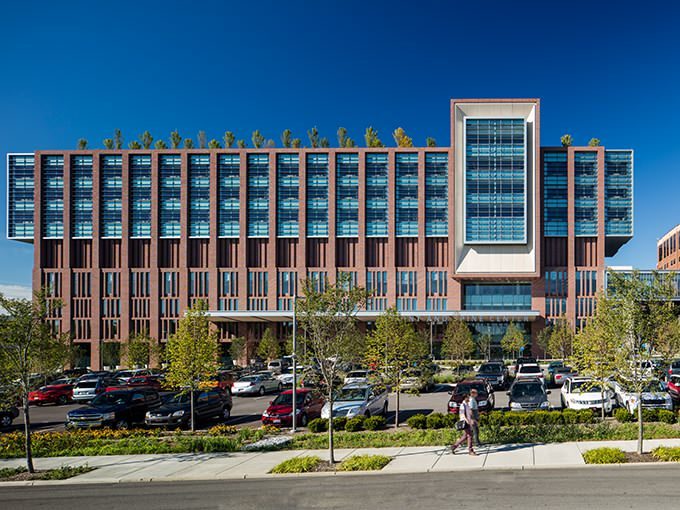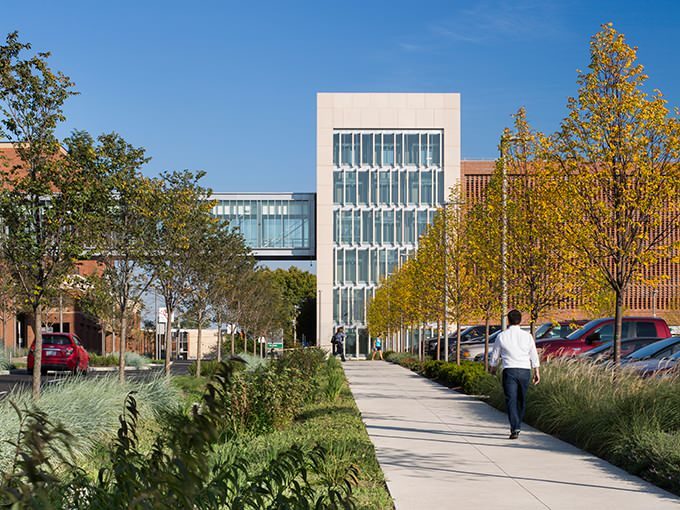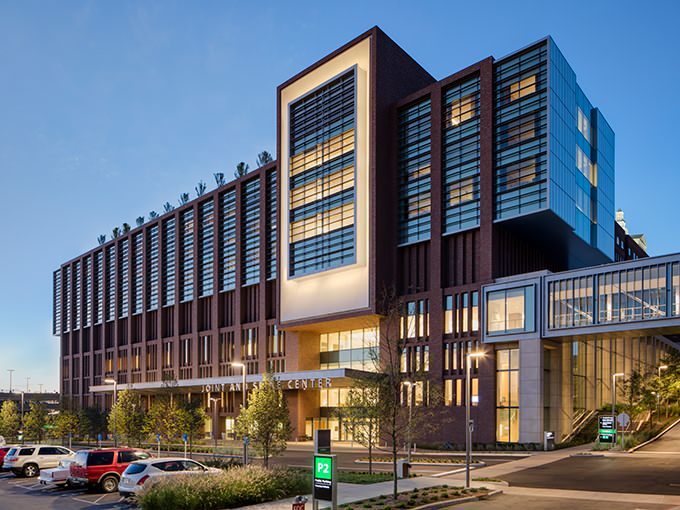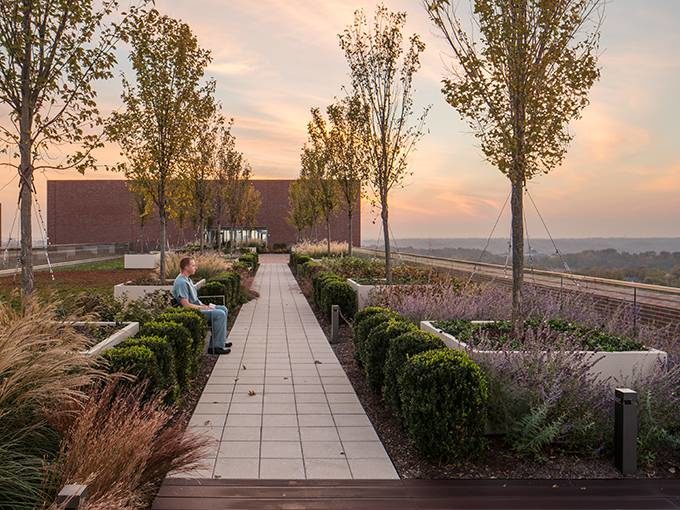



Cincinnati, Ohio: The Christ Hospital—a health care leader in the Cincinnati region—sought to unify their main campus and forge a model for integrated, patient-centered joint and spine care. Skidmore, Owings & Merrill LLP (SOM) worked with patients, medical professionals, and hospital staff to design the new Joint and Spine Center and to develop a cohesive master plan for the campus, addressing patients’ need for a state-of-the art, welcoming home for integrated care.
“The entire design and construction team worked very closely with the hospital’s leadership, staff, and users to create a place that facilitates and inspires well-being,” said SOM Design Partner Brian Lee. “From the patient room outwards, the design supports individuals, families, and their caregivers in the recovery process and makes visible The Christ Hospital’s vital role in Cincinnati and the region.” Lee noted, “The project is a surprisingly open, light-filled environment that combines the best thinking on how the patient and family should interact with medical professionals. It utilizes the latest available technology for the highest level of care, but in a humanized, comforting setting.”
The Joint and Spine Center increases connectivity at the Mount Auburn campus and brings rehabilitation, inpatient and outpatient surgery, imaging, pain management, and spaces for families and education under one roof. The 381,000-square-foot, seven-story facility, specially built for orthopedic care, adds approximately 90 private inpatient rooms and 12 surgical suites to the hospital campus. Spaces for patients are filled with daylight, and outside views are maximized to support well-being. Patient rooms have wall-to-wall, floor-to-ceiling frosted and clear glass, and patients are given electronic control of drapes that provide interior and exterior privacy if needed. Rooms follow a simple rectangular geometry like a bedroom—a familiar and understandable environment—and storage for ancillary equipment, patient and family possessions, and cabinetry for supplies and waste are kept out of view to create an uncluttered, comforting environment. An easy-to-use entertainment and information system, bathrooms with a residential character (including separate full-size showers and vanities), and flexible seating for visitors make patients and their families feel supported and respected throughout the healing process.
“The opening of the Joint and Spine Center allows us to transform the way care is delivered,” said Mike Keating, President and CEO of The Christ Hospital Health Network. “For patients, the Joint and Spine Center will provide access to the most advanced, integrated care for their personal needs. And, families will be able to care for their loved ones, alongside our talented physicians and nursing staff, closer to home. This Center supports our mission of improving the health of the community and creating patient value by providing exceptional outcomes, affordable care, and the finest experiences.”
Natural light extends into the core of the patient floor and traditionally “solid” elements like support and utility spaces are decentralized. There is a sense of openness and connectivity between opposite sides of the floor unlike most hospitals. “A light and airy environment is very beneficial for patients during the healing process. The patient-friendly and engaging environment allows for our doctors, nurses, and caregivers to provide exceptional care,” said Herb Caillouet, Executive Director of the Joint and Spine Center.
Compact nursing servers are placed next to patient rooms to allow caregivers to play a more active role in patient recovery and to keep the floor quiet by dispersing activity. The design also anticipates future needs, permitting the space to be converted to an intensive care unit in the future.
Family and staff breakout spaces adjoin window walls, with views to a planted central courtyard and to downtown Cincinnati. These quiet, welcoming spaces are programmed with comfortable furnishings for conversation and rest. Throughout the building, warm, sustainable materials, including wood finishes, create a tranquil and therapeutic environment. The high performance steel structure utilized prefabricated bathroom modules and MEP infrastructure to achieve a high-quality, cost-effective construction. The project was also designed to accommodate a future co-generation plant.
The Center’s position on the site makes it visible from both the University of Cincinnati campus to the north and the city’s downtown to the south, elevating The Christ Hospital’s important place in the community. Visually, the Joint and Spine Center’s exterior—composed of red brick and limestone—references the materials found in the vernacular architecture of the surrounding historic Mount Auburn neighborhood. The Center’s massing incorporates a projected “lantern” that accents the main entrance, extending up the height of the building. This gesture, a reinterpretation of the campus’ historic cupola, figuratively links The Christ Hospital’s history with its future.
Outside, soothing greenspaces encourage patients to spend time outdoors as they undertake their recovery. A landscaped courtyard between the old and new structures incorporates native plantings, pergolas, and benches, while a new green roof garden with stunning views of the city skyline provides a place of respite for staff and patients.
A master plan for the campus clarified circulation and unlocked the decades-old aggregation of additions. A new concourse and entry linked the Joint and Spine Center to existing buildings and connected the center to a new parking garage via a skybridge. A new north-south alignment of utilities and vehicular and pedestrian movement enables future expansion of the campus to the south. The design team also brought order to a color-coded wayfinding system that had grown into a complex patchwork of over 20 colors by introducing a new scheme focused on simplicity and clarity.
Anticipating future needs and placing the patient and their caregivers first, the Joint and Spine Center at The Christ Hospital demonstrates that design can foster recovery and create a more humane environment for the critical work of The Christ Hospital’s medical professionals.
About Skidmore, Owings & Merrill LLP
Skidmore, Owings & Merrill LLP (SOM) is one of the leading architecture, interior design, engineering, and urban planning firms in the world, with an 80-year reputation for design excellence and a portfolio that includes some of the most important architectural accomplishments of the 20th and 21st centuries. Since its inception, SOM has been a leader in the research and development of specialized technologies, new processes and innovative ideas, many of which have had a palpable and lasting impact on the design profession and the physical environment. The firm’s longstanding leadership in design and building technology has been honored with more than 1,700 awards for quality, innovation, and management. The American Institute of Architects has recognized SOM twice with its highest honor, the Architecture Firm Award—in 1962 and again in 1996. The firm maintains offices in New York, Chicago, San Francisco, Los Angeles, Washington, D.C., London, Hong Kong, Shanghai, Mumbai, and Abu Dhabi.